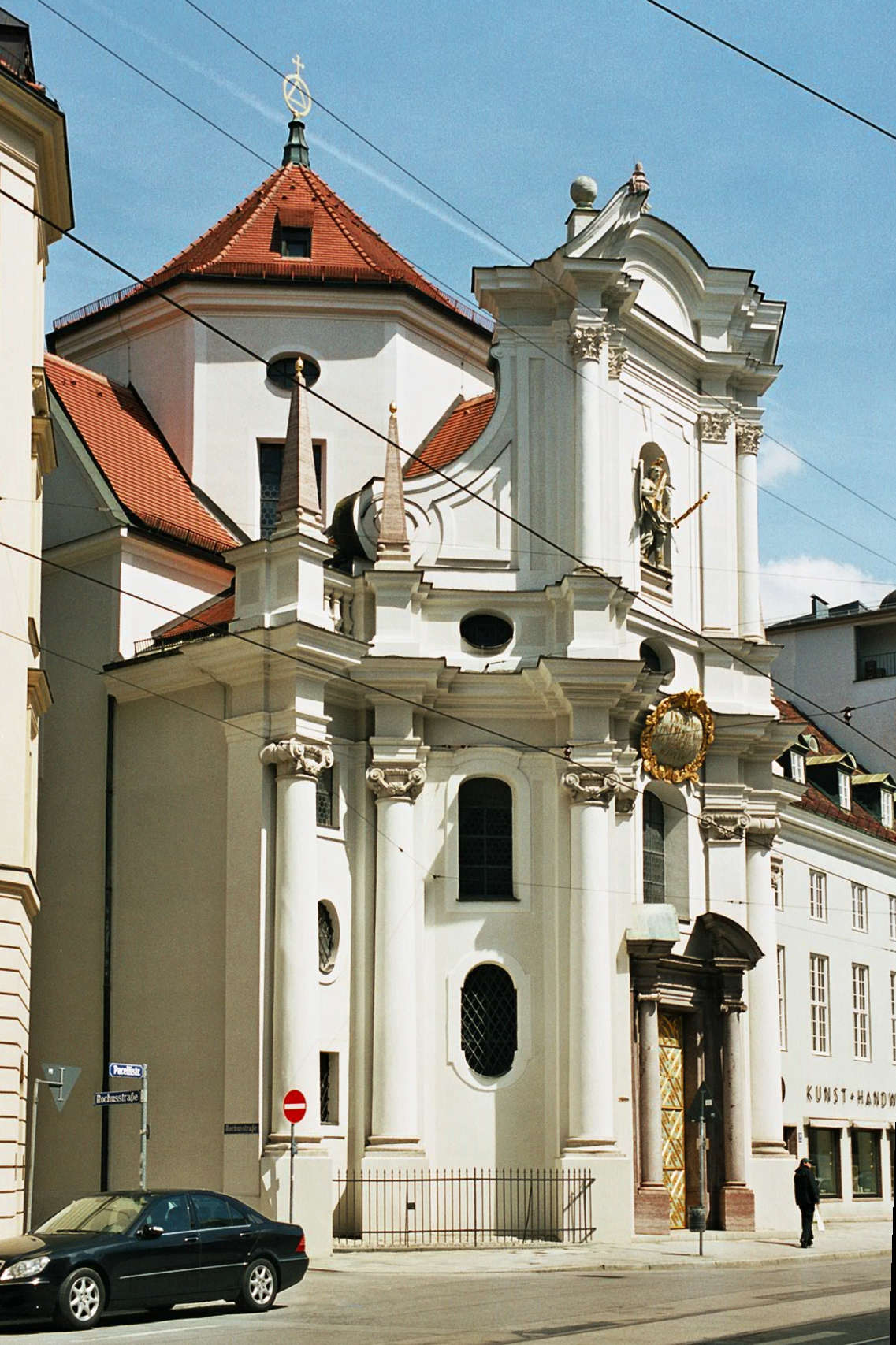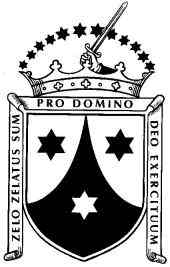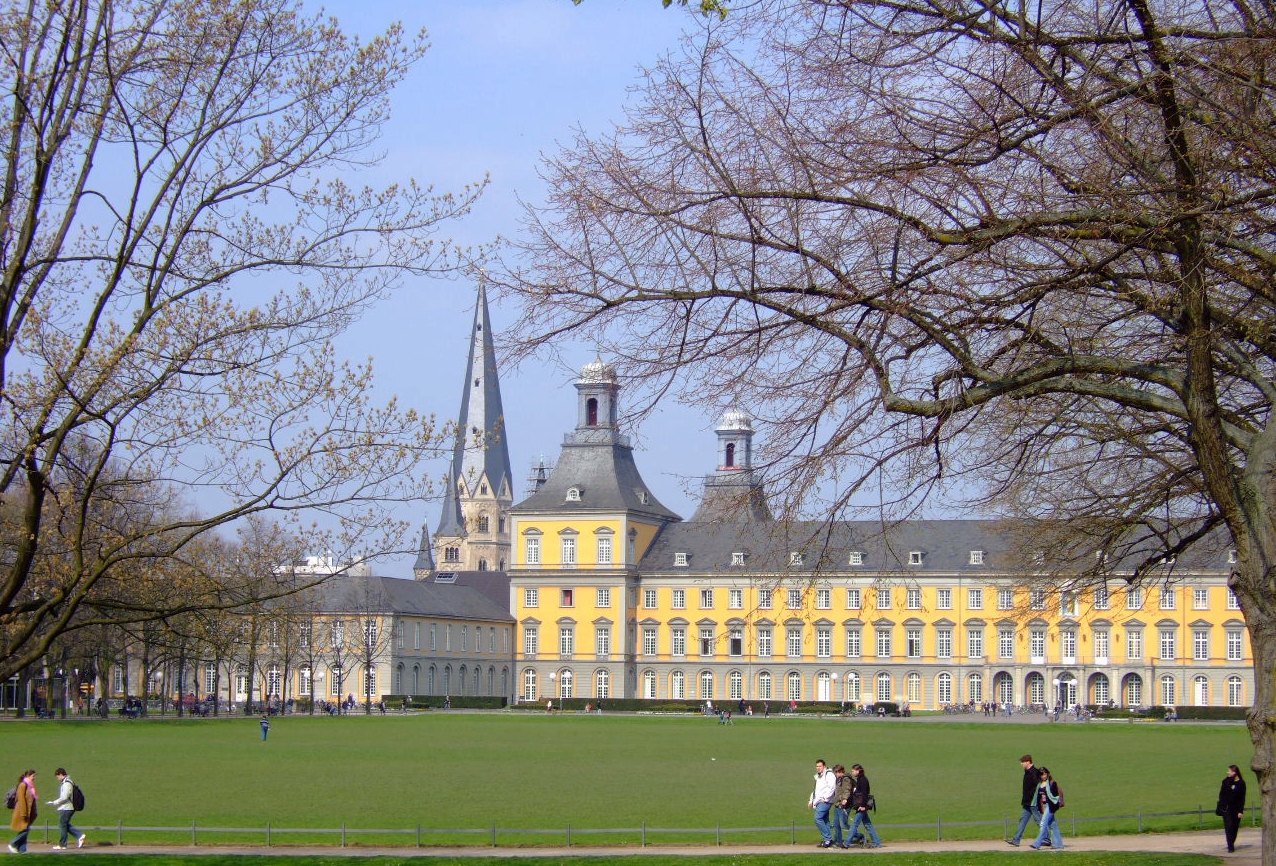|
Trinity Church (Munich)
The Trinity Church is a religious building in Munich, southern Germany. It is a votive church and was designed in Bavarian Baroque style according to plans from Giovanni Antonio Viscardi from 1711 to 1718. It is a monastery church of the Carmelites and a church of the Metropolitan parish of Our Blessed Lady. During the Second World War this was the only church in the center of Munich, which had been spared from destruction by bombs. A pledge was kept (due to the prophecy of Anna Maria Lindmayr); people hoped to be spared by the Austrians during the Spanish Succession war. Architecture The church is Munich's first church building in late baroque style. The central building, with its dome and elaborate entrance, was built after Viscardi's death in 1713 by Enrico Zuccalli. The double-faced south façade protrudes the front of the houses of the street. The polygonal main entrance is divided by columns and strong baroque cornices. Important works by Cosmas Damian Asam (ceiling p ... [...More Info...] [...Related Items...] OR: [Wikipedia] [Google] [Baidu] |
Dreifaltigkeitskirche Muenchen-2
Dreifaltigkeitskirche (German for ''Trinity Church'') may refer to: ;Austria * Church of the Holy Trinity, Salzburg in Salzburg ;Australia * Lutheran Trinity Church, East Melbourne, a German-language church known as ''Deutsche Evangelische Dreifaltigkeitskirche'' ;Germany: *Dreifaltigkeitskirche (Berlin) *Dresden Cathedral, or the Cathedral of the Holy Trinity, previously the Catholic Church of the Royal Court of Saxony *Trinitatiskirche (Dresden), in ruins *Dreifaltigkeitskirche (Munich) * Dreifaltigkeitskirche (Speyer) ;Switzerland * Dreifaltigkeitskirche, Bern, from 1899 See also *Holy Trinity Church (other) Holy Trinity Church may refer to: Albania * Holy Trinity Church (Berat), Berat County * Holy Trinity Church, Lavdar, Opar, Korçë County Armenia * Holy Trinity Church, Yerevan Australia * Garrison Church, Sydney, South Wales, also known as ... * Trinity Church (other) {{disambiguation, church ... [...More Info...] [...Related Items...] OR: [Wikipedia] [Google] [Baidu] |
Munich
Munich ( ; german: München ; bar, Minga ) is the capital and most populous city of the German state of Bavaria. With a population of 1,558,395 inhabitants as of 31 July 2020, it is the third-largest city in Germany, after Berlin and Hamburg, and thus the largest which does not constitute its own state, as well as the 11th-largest city in the European Union. The city's metropolitan region is home to 6 million people. Straddling the banks of the River Isar (a tributary of the Danube) north of the Bavarian Alps, Munich is the seat of the Bavarian administrative region of Upper Bavaria, while being the most densely populated municipality in Germany (4,500 people per km2). Munich is the second-largest city in the Bavarian dialect area, after the Austrian capital of Vienna. The city was first mentioned in 1158. Catholic Munich strongly resisted the Reformation and was a political point of divergence during the resulting Thirty Years' War, but remained physicall ... [...More Info...] [...Related Items...] OR: [Wikipedia] [Google] [Baidu] |
Germany
Germany, officially the Federal Republic of Germany (FRG),, is a country in Central Europe. It is the most populous member state of the European Union. Germany lies between the Baltic and North Sea to the north and the Alps to the south. Its 16 constituent states have a total population of over 84 million in an area of . It borders Denmark to the north, Poland and Czechia to the east, Austria and Switzerland to the south, and France, Luxembourg, Belgium, and the Netherlands to the west. The nation's capital and most populous city is Berlin and its main financial centre is Frankfurt; the largest urban area is the Ruhr. Settlement in what is now Germany began in the Lower Paleolithic, with various tribes inhabiting it from the Neolithic onward, chiefly the Celts. Various Germanic tribes have inhabited the northern parts of modern Germany since classical antiquity. A region named Germania was documented before AD 100. In 962, the Kingdom of Germany formed the ... [...More Info...] [...Related Items...] OR: [Wikipedia] [Google] [Baidu] |
Giovanni Antonio Viscardi
Giovanni Antonio Viscardi (27 December 1645 – 9 September 1713) was a Swiss architect of the baroque, who worked mostly in Bavaria. Biography Giovanni Antonio Viscardi was born in San Vittore, Grisons. He was descended from a family which provided several architects who had worked in Bavaria, Styria and Mainz. He started his career as a Superintendent to Enrico Zuccalli before 1675; in 1678 he was appointed master mason and in 1685 chief architect. Dismissed in 1689, Viscardi worked as an independent architect until he became Zuccalli's successor as chief architect of the Bavarian court in 1706 with the Austrian occupation of Bavaria; he died, aged 67, in Munich, while still in office. Chief works * Mariahilfkirche at Freystadt Abbey :''"Freystadt" is also the German names for Kisielice and Kożuchów, Poland.'' Freystadt (; Northern Bavarian: ''Freystod'') is a town in the district of Neumarkt in Bavaria. It is situated near the Rhine-Main-Danube Canal, 14&nb ... [...More Info...] [...Related Items...] OR: [Wikipedia] [Google] [Baidu] |
Carmelites
, image = , caption = Coat of arms of the Carmelites , abbreviation = OCarm , formation = Late 12th century , founder = Early hermits of Mount Carmel , founding_location = Mount Carmel , type = Mendicant order of pontifical right , status = Institute of Consecrated Life , membership = 1,979 (1,294 priests) as of 2017 , leader_title = Motto , leader_name = la, Zelo zelatus sum pro Domino Deo exercituumEnglish: ''With zeal have I been zealous for the Lord God of hosts'' , leader_title2 = General Headquarters , leader_name2 = Curia Generalizia dei CarmelitaniVia Giovanni Lanza, 138, 00184 Roma, Italia , leader_title3 = Prior General , leader_name3 = Mícéal O'Neill, OCarm , leader_title4 = Patron saints , leader_name4 = Our Lady of Mt. Carmel, Elijah , parent_organization = Catholic Church , website = ... [...More Info...] [...Related Items...] OR: [Wikipedia] [Google] [Baidu] |
War Of The Spanish Succession
The War of the Spanish Succession was a European great power conflict that took place from 1701 to 1714. The death of childless Charles II of Spain in November 1700 led to a struggle for control of the Spanish Empire between his heirs, Philip V of Spain, Philip of Anjou and Charles VI, Holy Roman Emperor, Charles of Austria, and their respective supporters, among them Spanish Empire, Spain, Habsburg monarchy, Austria, Kingdom of France, France, the Dutch Republic, Savoyard state, Savoy and Kingdom of Great Britain, Great Britain. Related conflicts include the 1700–1721 Great Northern War, Rákóczi's War of Independence in Kingdom of Hungary (1526–1867), Hungary, the Camisards revolt in southern France, Queen Anne's War in North America and minor trade wars in colonial India, India and New Spain, South America. Although weakened by over a century of continuous conflict, Spain remained a global power whose territories included the Spanish Netherlands, large parts of Italy, ... [...More Info...] [...Related Items...] OR: [Wikipedia] [Google] [Baidu] |
Enrico Zuccalli
Enrico Zuccalli (''Johann Heinrich Zuccalli''; c. 1642 – 8 March 1724) was a Swiss architect who worked for the Wittelsbach regents of Bavaria and Cologne. Biography Zuccalli was born in Roveredo, Switzerland. From 1669 he lived in Munich and became a major representative of the introduction of Italian Baroque architecture to Germany. He was a bitter rival of another Swiss architect, Giovanni Antonio Viscardi. In 1672 Zuccalli became chief architect of the Bavarian court as successor of Agostino Barelli and remained in office until the Austrian invasion of Bavaria in 1706. He died in Munich. He was the uncle of (Giovanni) Gaspare Zuccalli who built two churches at Salzburg. Chief works * Theatinerkirche (Munich) since 1674 (completing the work of Barelli) * Residenz, Munich (1680–1701) * Lustheim Palace (1684–1689) * Palais Porcia in Munich (1694) * Electoral Palace of Bonn (1697–1702) (later completed by de Cotte) * Schleissheim Palace (1701–1704) (later co ... [...More Info...] [...Related Items...] OR: [Wikipedia] [Google] [Baidu] |
Cosmas Damian Asam
Cosmas Damian Asam (29 September 1686 – 10 May 1739) was a German painter and architect during the late Baroque period. Born in Benediktbeuern, he lived in Rome from 1711 to 1713 to study at the Accademia di San Luca with Carlo Maratta. In 1713, Asam won the Academy's first prize for his drawing of ''Miracle of Saint Pio''. In Germany, he worked with his brother Egid Quirin, a sculptor and stucco worker, on building and decorating entirely new churches (such as the Asam Church in Munich) or redesigning churches in the Baroque style ( Regensburg— Benedictine Monastery Church of St. Emmeram). Their joint projects are often attributed to the "Asam Brothers". Cosmas Damian died in Munich. Major works The Asam Brothers, singularly and together, were very prolific artists. They typically worked for Benedictine monasteries, though they occasionally took secular commissions. Cosmas Damian's altar depicting The Vision of St. Benedict in Weltenburg— Monastery Ch ... [...More Info...] [...Related Items...] OR: [Wikipedia] [Google] [Baidu] |
Joseph Ruffini
Joseph or Giuseppe Ruffini (1690 - February 7, 1749) was an Italian- Austrian painter, mainly active in Germany. Biography He was born in Merano in the Tyrol. He trained with his father, and by 1711 he had moved to work in Munich in Bavaria. He is best known for his late- Baroque cycle of paintings for the Ottobeuren Abbey Ottobeuren is a Benedictine abbey, located in Ottobeuren, near Memmingen in the Bavarian Allgäu, Germany. For part of its history Ottobeuren Abbey was one of the 40-odd self-ruling imperial abbeys of the Holy Roman Empire and, as such, was a vi .... He died in Bavaria. References 1690 births 1749 deaths People from Merano 18th-century Italian painters Italian male painters Italian emigrants to Austria 18th-century Italian male artists {{Italy-painter-18thC-stub ... [...More Info...] [...Related Items...] OR: [Wikipedia] [Google] [Baidu] |
Andreas Faistenberger
Andreas ( el, Ἀνδρέας) is a name usually given to males in Austria, Greece, Cyprus, Denmark, Armenia, Estonia, Ethiopia, Eritrea, Finland, Flanders, Germany, Norway, Sweden, Switzerland, Romania, the Netherlands, and Indonesia. The name derives from the Greek noun ἀνήρ ''anēr'', with genitive ἀνδρός ''andros'', which means "man". See the article on ''Andrew'' for more information. The Scandinavian name is earliest attested as antreos in a runestone from the 12th century. The name Andrea may be used as a feminine form, but is instead the main masculine form in Italy and the canton of Ticino in Switzerland. Given name Andreas is a common name, and this is not a comprehensive list of articles on people named Andreas. See instead . Surname * Alfred T. Andreas, American publisher and historian * Casper Andreas (born 1972), American actor and film director * Dwayne Andreas, a businessman * Harry Andreas * Lisa Andreas Places *Andreas, Isle of Man, a village an ... [...More Info...] [...Related Items...] OR: [Wikipedia] [Google] [Baidu] |
Johann Baptist Straub
Johann Baptist Straub (1 June 1704 (baptism) – 15 July 1784) was a German Rococo sculptor. Biography Straub was born in Wiesensteig, into a family of sculptors. His father Johann George Straub and his brothers Philipp Jakob, Joseph, and Johann Georg Straub were also sculptors, as was his nephew Franz Xaver Messerschmidt. J. B. Straub studied in Munich with the court sculptor Gabriel Luidl and then went to Vienna, where he worked from 1726 to 1734. In 1734 Straub returned to Munich. In 1737 he was appointed by Elector Karl Albrecht from Bavaria as the court sculptor. In the same year Straub married a daughter of the court engraver, Franz Xaver Späth. Straub worked primarily in Upper Bavarian churches and monasteries, frequently alongside some of the greatest Baroque artists of the day: the architect Johann Michael Fischer, the painter Johann Baptist Zimmermann, the Asam Brothers, the Tyrolian painter Johann Jacob Zeiller, and the stuccoists Franz Xaver and Johann ... [...More Info...] [...Related Items...] OR: [Wikipedia] [Google] [Baidu] |





